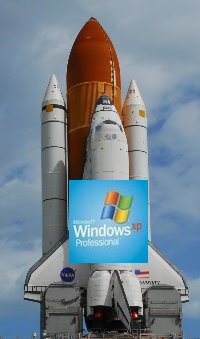 No, my dear Linux buddies, Windows XP will not be shot to the moon and earth will be relieved of it. But … it will be shot to the space station.
No, my dear Linux buddies, Windows XP will not be shot to the moon and earth will be relieved of it. But … it will be shot to the space station.
Being a computer guy, that news drew my attention: nasaspaceflight.com reports that Windows XP will be rocketed into orbit with space shuttle Discovery’s STS-120 mission. If I may summarize the deep technical content of the original article:
The space shuttle uses a variety of computers for different purposes. First of all, relax: Windows XP, nor any other off-the-shelf system, will not control essential shuttle operations like starting and stopping the main engines. However, there are a number of utility functions that are performed by the usual hard- and software that is also setting on our very own desktops. The news source claims that they are used for up- and downloading imagery, mission documentation and emails. I assume NASA does this for cost reasons. A failure in such a system is probably not problematic at all.
What I found even more stunning is what Windows XP has been upgraded from: previous missions used Windows ME! Have you ever watched live NASA TV during a shuttle mission? From time to time (frequently enough), you hear somebody saying “the computer hang, I rebooted it”. I now no longer wonder why … ;)
To come back to the side of seriousness: Of course Windows ME was not the most stable operating system on earth, umm, in the solar system. But the main reason for in-orbit computer malfunction are cosmic rays. Even though the shuttle orbits well within earth’s protective geomagnetic field, the exposure to high energy cosmic particles is much larger in an orbiting spacecraft. Everyday electronics, like the one used in the “auxiliary computers” is not hardened against it. So every now and then a cosmic particle will put an electron to where it does not belong to in turn causing some computer failure — a good cause for a system hang.
So when the next time a computer needs to be rebooted in the space shuttle, do not (just) blame Microsoft for it ;)
